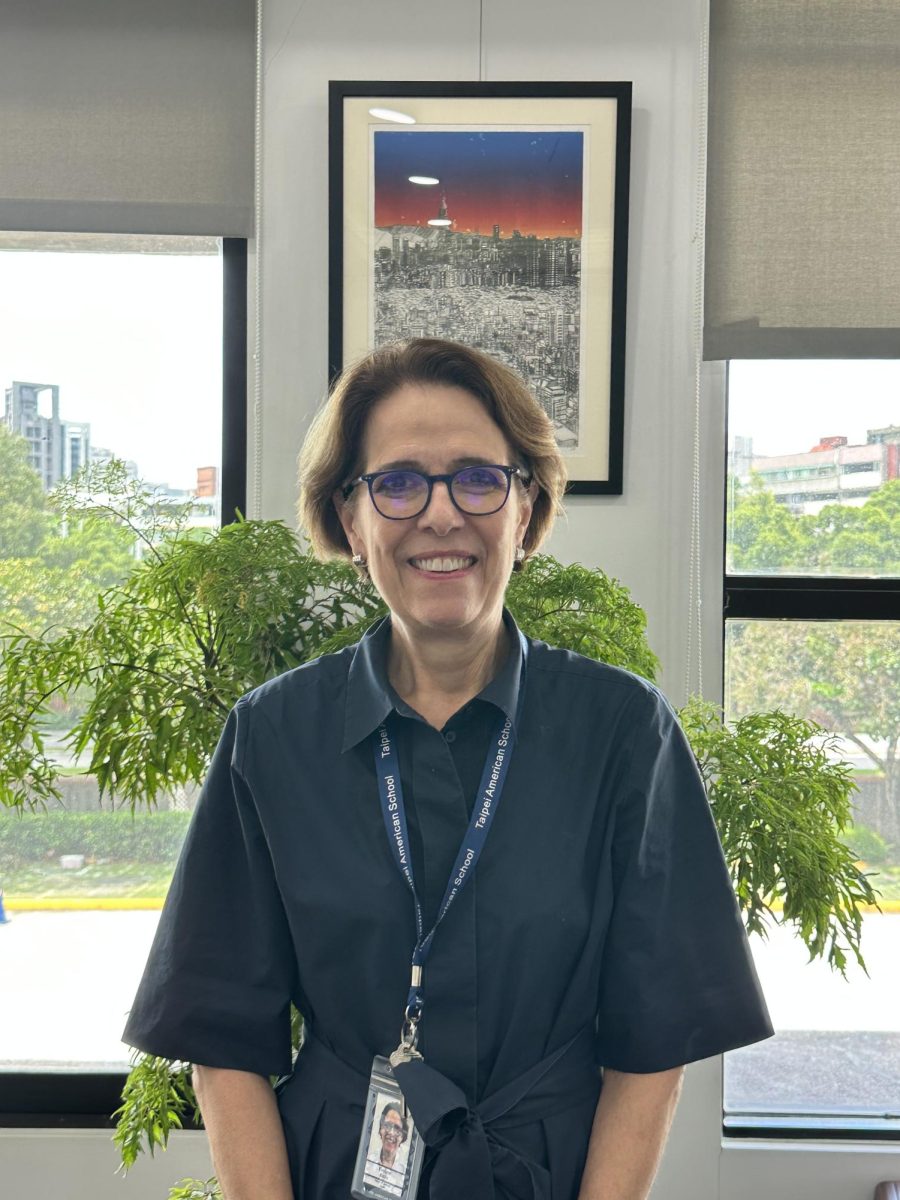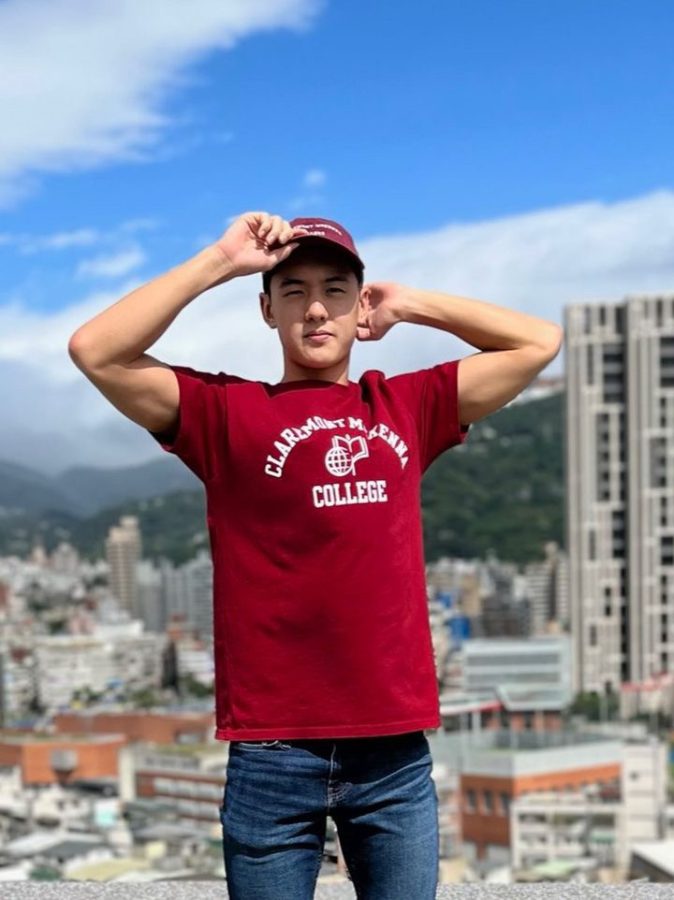Christine Wan: art without a tradition canvas
The whale shark in Christine Wan’s (11) digital portrait is terminally ill, but not from any common disease: instead, it has fallen to technology, a virus unlike any other. “Today, digital platforms are society’s primary way of interacting with nature,” she explains. “That concept is shown through the chromatic aberrations over the shark, which put a visual wall between the man viewing the scene and his surroundings.”
This juxtaposition between nature’s purity and the artificial medium through which it is experienced is inspired by Wan’s own disconnect from nature: “I often hear my dad talking about catching cicadas, playing with snakes, or fishing in a nearby lake,” she says. “But because of irreversible damage, our generation will have much fewer opportunities to interact with the environment.”
Christine will present this project, titled “Through the Monitor,” at the IASAS Cultural Convention in Kuala Lumpur. “I chose it because it was very representative of my portfolio, which focuses on human-nature interaction,” she says. “I’m very drawn to that theme. I guess it’s to compensate for the time I could’ve spent appreciating nature.”
She also chose this social commentary piece because it was her most developed and technically advanced. At the same time, she constantly aspires to higher goals. “Well, I’m finished with my piece,” Christine says. “As in, I’ve stopped working on it for now. But like Da Vinci said, ‘artwork is never finished, only abandoned.’”
Her aspirations for perfection are closely linked to her original sentiments toward art. “I would constantly compare my work with those around me,” she says. “So unlike other artists who picked up crayons at age one, I hated art as a kid.” She later began to enjoy the process of making artwork, moving from origami to sewing to drawing over the course of her lower and middle school years.
As a Tiger Baby, Christine has gone through the entire 13-year arts curriculum at TAS; in spite of this, she is actually a newcomer to the IASAS Art program this year. “As crazy as it sounds, I’m thinking of applying for an art major in college,” she says. “It used to be just a hobby, but art has become really central to my life and I want to take that outside of high school.”
Michael Wen: from tap to contemporary
When Michael Wen (12) first walked into his Dance/PE class in sophomore, he could not even touch his toes. However, after performing the stretching and conditioning exercises for a month, he found that not only did he [improve], but also that it helped him relieve stress. “The body movement was very relaxing. Unlike other classes, I didn’t have to worry about academics.” Now, stretching remains one of his favorite aspects of dance. He says, “I feel like I get to understand my body so I can push myself when learning and creating movement.”
Michael’s dance journey began at five years old, when he took tap dancing classes in [country he lived in], but he stopped in fifth grade after his move to Taiwan. He credits the Dance/PE class for allowing him to rediscover his passion for dance. “Although I initially joined dance to fulfill the PE requirement, I enjoyed the class so much that I decided to continue with IB, dance productions, and dance teams,” says Michael.
He emphasizes that confidence is an important part of dance. “It is very scary to try a lift I haven’t performed before because I don’t want to be giving people concussions,” says Michael. “I need to really trust myself and my dance partners.” The dancers also need to get out of their comfort zones when choreographing during rehearsals, which happen every day except Sunday. “We all have movements that we do too much because we are comfortable with them,” he says. “To find unique movements, we often get in awkward positions and get floor burns, which are the worst.” However, the long hours and bruises are [worth it]when the dancers perform their 20-minute pieces at the Cultural Convention.
Michael plans to continue exploring new forms of dance in the future. “I hope to learn ballroom dancing in college and maybe even pick up tap dancing again,” he says.
Happy Moo: genius co-lyricist of a new musical
For the first time in IASAS history, the group will be creating their own play from scratch, based loosely on the plot of The Breakfast Club. They will be taking tunes from familiar Broadway musicals, from The Book of Mormon to Hamilton, and adapting them to fit in in a play of their own. The final song, however, will be Happy’s own composition. It is an original piece written for the play, a process which challenged her. “It’s different from other songs I’ve written before because I have to consider every direction,” she says. “The harmony, build up, and overall feeling involved in creating a song for a musical is challenging in a way I haven’t approached music before.”
The production is especially demanding for all actors on the team, especially since the they write the dialogue “as they go”, according to Happy. is not an actor, but she was selected to join the IASAS Drama team onstage as a pianist. “This year, all of our music is going to be live on the stage,” she says. Many of the actors are also musicians, so they will be joining her in instrumentals, but Happy will be accompanying the whole show. “I’m so excited for performance day, when we’ll finally be on stage and our work will be showed to an audience,” she says.
Brian Kuo: he’s Julliard material
Brian Kuo (11) was nine years old when he made his first performance faux pas, forgetting the rest of his piece in the middle of an arpeggio run. So he stood up to face the audience and announced, “I forgot!”
“Since then, memorizing has been the easiest part of performing from me,” he says. Trial and error plays a large role in his cello performance, and he can usuall
y found in the auditorium during free periods, experimenting with other musicians. As a cellist who primarily performs solo, Brian’s interactions with other musicians every year at IASAS are special for him. “It’s interesting, how the program fosters collaboration between students,” Brian says. “Through that, you’re able to learn in a way that you’re unable to individually.”
The IASAS Octet has just started working on their piece for the IASAS Cultural Convention, the Mendelssohn Octet. During orchestra classes and after school, the group now logs three to six practice sessions a week. These sessions involve not only individual practice, but coachings from professional musicians, as well as in-depth studies of the composition.
“Mendelssohn wrote the piece when he was 16 — what are we doing with our lives?” Brian quips. In fact, Brian has begun a composing venture of his own: a viola sonata, which will be premiered at the Cultural Convention by Terry Chung (12) and accompanist Alvin Hsu (12).
Brian’s sonata cleverly compiles styles spanning from familiar, canonized Bach to the esoteric, controversial Prokofiev, a testimony to his appetite for music appreciation. “I admire the complexity and dynamics of all the different styles, genres, and instrumentation,” says Brian. “It never gets old: even now, my favorite piece changes every time I listen to a concerto.”
“I remember listening to a chamber music ensemble when I was small and picking out the sound of the cello,” he says. “I’ve loved it ever since.” While he does not plan on becoming a musician as a career, he hopes to maintain it as a lifelong hobby. His future for composing is more unclear. “I’ve really liked my first interactions with composing so far,” Brian says. “It’s a lot of work, but looking at the final product and hearing someone else play it a unique experience.”
Juliana Kao: the control booth is her habitat
When one attends a performance of Juliana Kao’s (12) favorite musical, The Phantom of the Opera, it quickly becomes clear that the star of the show is not the main character, Christine, or, in fact, any cast member at all. Instead, the honor goes to a figure much more surprising: the chandelier.
While the lighting fixture takes up less than a minute of showtime, the chandelier more than makes up for it in sheer shock value, unexpectedly crashing down from the ceiling mid-performance. And all who see the show, from the most inexperienced amateurs to seasoned industry professionals, cite it as a defining moment.
Management of stunning effects like these makes Tech the lifeblood of theater, even though the TAS’s own team is seldom recognized as such. “For every production there is so much that goes on backstage: lights, sound, running crew, rigging, stage managing, costumes, makeup, set-building…” Juliana says. “There are so many things the audience doesn’t know about, but which are essential to the production.”
Juliana herself manages lights, and has “teched” for countless performances since middle school, from the Mean Girls production to dance showcases and more. She has also learned about several of the other operations behind the scenes, dabbling in different areas and learning from her friends.
As a senior, she plans to continue with tech in college, looking for universities with good thespian programs. “Tech sharpens skills that are applicable in daily life,” Juliana says. “Managing multiple things at once, fast problem solving skills, and a cool head are all things you learn which are important elsewhere, too.” She also hopes to find a community similar to the one she found in TAS. “I like that it feels like I’ve become part of one big family over the years,” she says. “Everyone who is a part of it is always there for each other. It’s a great community to be a part of.”
Aaron Gould: he’s game for forensics and debate
“My first word was ‘no’,” says Aaron Gould (12). “Clearly, I was destined to be a debater.” But his journey towards perfecting the art of disagreement really began in freshman year as a 2014 IASAS debate team researcher. Since then, he has participated in six debate tournaments, including the Tournament of Champions Public Forum in Kentucky to the 2016 Cultural Convention in Kuala Lumpur.
This year, Aaron is one of seven students representing Taipei American School at the IASAS Cultural Convention in Bangkok, along with Alan Tsai (12), Gene Chou (11), Eliot Wang (11), McKenzie Engen (9), Kelly Phil (9), and alternate Si Yun Ee (10).
“Even when he is speaking gibberish, he sounds like he knows what he’s doing,” remembers Theodora Tang (11), who competed in the 2016 Tournament of Champions Public Forum alongside Aaron. Throughout his debate career, he has befuddled teammates from saying things like “To solve a puzzle, you have to get all the puzzles” to making up words like “fantastiliculous”.
“When you do not know what to do,” Aaron says, “take a deep breath and fake it.” And if you fail, “learn and move on.”
For him, debate is most of all about learning to be unafraid. He especially enjoys practice sessions where the team is out of its depth: speaking with pens in their mouths, shouting at each other at the top of their lungs, or holding their own against their coach, Dr. Coburn-Palo.
“I learn a lot from researching and debating,” says Aaron. “It’s an activity that trains nuance, because there is no single correct answer. You have to know both sides of the argument.”








![Members of Flourishing Love arrange bouquets together. [PHOTO COURTESY OF FLOURISHING LOVE]](https://blueandgoldonline.org/wp-content/uploads/2023/12/fl-1200x900.jpeg)
![Members of Formosa Charity reconstruct an old home. [PHOTO COURTESY OF CHAEWON B. (25)]](https://blueandgoldonline.org/wp-content/uploads/2023/12/bwb.jpeg)


![Catrina was waitlisted at Caltech but
intends to pursue Computer Engineering
at the University of Washington. [PHOTOS
COURTESY OF CATRINA Y.]](https://blueandgoldonline.org/wp-content/uploads/2023/05/Copy-of-IMG_4544-900x602.jpg)
![Honors Film 3 and 4 students set up the camera and microphone to get ready for an interview. [PHOTO COURTESY OF TAS FILM]](https://blueandgoldonline.org/wp-content/uploads/2023/05/DSC09834-900x507.jpg)